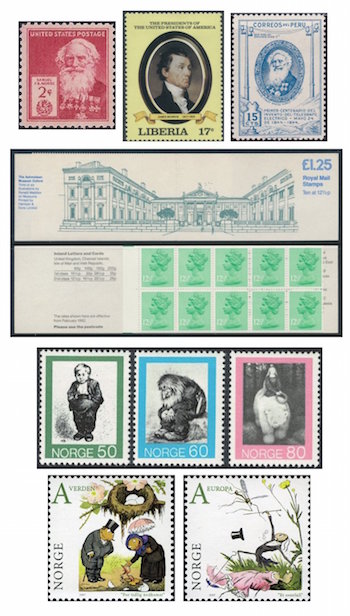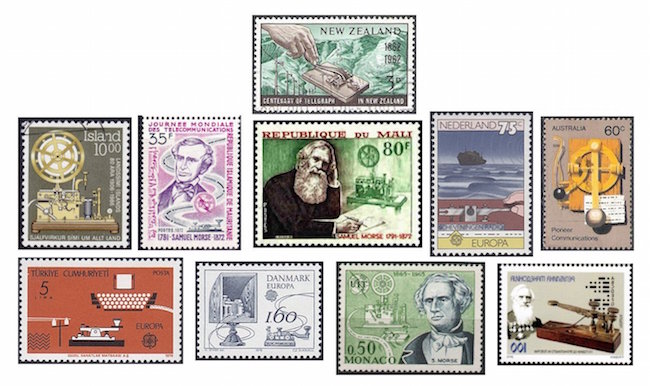The Arts on the Stamps of the World — April 27
An Arts Fuse regular feature: the arts on stamps of the world.

By Doug Briscoe
Did you know that inventor Samuel F. B. Morse (April 27, 1791 – April 2, 1872) was also a painter? I didn’t. Of course, he is not remembered on stamps for his canvases, but he is for his code, and I’ll display a lot of those stamps at the end of today’s presentation. Morse studied painting at the Royal Academy in London from 1811. Later, in addition to genre pieces, he painted portraits of John Adams, James Monroe (whose birthday happens to be tomorrow), the Marquis de Lafayette, and Eli Whitney. The only one of these I could find on a stamp is the Monroe portrait, as seen on a 1981 Presidential issue from Liberia, which I’ve placed between Morse stamps from the US and Peru. (The Wikipedia article provides images of a number of Morse’s paintings for those curious to see them.)
All of our other creative spirits today are—how shall I say this delicately without impugning their work?—second-raters. The first (chronologically) doesn’t even have a proper stamp. English architect Charles Cockerell (27 April 1788 – 17 September 1863), who was also an archaeologist and writer, gave us the Ashmolean Museum in Oxford (built 1841-45). Its collections had been housed at other locations since the museum’s founding (the first university museum in the world) in 1683. Our makeshift philatelic substitute is the cover for a booklet of definitive Royal Mail stamps of 1982.
Theodor Kittelsen (27 April 1857 – 21 January 1914) is highly regarded in his native Norway for his trolls. But I oversimplify: Kittelsen did indeed focus on fairy tales and legends as the subjects for his art, and he is no doubt particularly esteemed for that body of work, but he also produced nature paintings, one of which is Echo (1888), which I find to be a wonderfully evocative scene. The only stamps I could find for him, though, are ones that show his folk tale illustrations. (Recently we acknowledged the Swedish painter Ernst Josephson with a stamp showing his Näcken, or Nøkken, a folkloric incubus also chosen as a subject by Kittelsen, whose version is a very different concept.) When Kittelsen was seventeen his talent was recognized by the art historian Diderich Maria Aall, whose financial support made it possible for Kittelsen to study in Munich. Subsequent to that he received a state grant for further study in Paris, returning to Norway permanently in 1887. He received a government stipend but died in poverty. There is a museum at Blaafarveværket in south central Norway that I imagine must be a delight to visit.

Sadriddin Ayni (27 April 1878 – 15 July 1954) is viewed by many as Tajikistan’s national poet. He was also a journalist who wrote fiction and history. He was born in what at the time was the Emirate of Bukhara in what used to be called Transoxiana, the exotic and mysterious land of Samarkand with its heady perfumes and unspoken promises. Uh, where was I? Oh, yes, Sadriddin Ayni. Orphaned at twelve, he was sent to study at a madrasa in the capital, where he learned to write Arabic. Why did the Soviet Union honor him with not one but two stamps (1954 and 1968), one may reasonably inquire? I suppose it may have something to do with the fact that Ayni was a vigorous supporter of the Bolshevik Revolution in Tajikistan and Uzbekistan and served in the Supreme Soviet of Tajikistan for twenty years and was thrice awarded the Order of Lenin. Or perhaps it’s because he wrote what is considered the first novel in the Tajik language, Dokhunda, in 1927. He is also the author of a four-volume memoir, Yoddoshtho, considered his most important work.
Howard Coster (1885–1959) described himself as a “Photographer of Men”. Following the example of the American Pirie MacDonald, Coster’s London studio, opened in 1925, catered to men only, some of his subjects being John Galsworthy, G. K. Chesterton, Aldous Huxley, and J. B. Priestley, though Coster’s most celebrated photo is one he took of A. A. Milne with his son Christopher Robin.

Norwegian poet Arnulf Øverland (27 April 1889 – 25 March 1968) was nominated for the Nobel Prize in Literature no fewer than thirteen times. Born in Kristiansund and raised in Bergen, he was a Communist from the 20s until disgusted by the purges of the 30s. A man of courage and principle, he was prosecuted for blasphemy in 1933 after writing an article called “Christianity – the tenth plague” (he was aquitted), and arrested with his wife during the Nazi occupation for privately circulating antifascist poems and sent to Sachsenhausen (he survived).
Bulgarian painter Bencho Obreshkov (27 April 1899 – 8 April 1970) studied under Oskar Kokoschka in Dresden and sculptor Antoine Bourdelle in Paris in the mid-1920s. He returned to Bulgaria in 1927 and went on to establish himself as one of his country’s top painters. He was, however, accused of “formalism” by the Communists and even temporarily expelled from the Union of Bulgarian Artists. Landscapes, still lifes, and portraits were his métier. Alas, some 250 of his pieces (350, according to another source) were destroyed in the Allied bombing of Sofia in 1944. Our first stamp shows his Village (I can’t find a date for this); the second is Grape-gatherer (1945); and the most recent stamp juxtaposes his portrait with a painting of another of his favorite subjects, Boats, though again, I was unable to learn more about this particular work. For more examples of Obreshkov’s art, visit Mutual Art.
Turkish classical musician Münir Nurettin Selçuk, born around 1900, died on this day in 1981. The nephew of a Grand Vizier of the Ottoman Empire, Selçuk studied music from fifteen, with an hiatus during which he studied agriculture in Hungary. He wrote two songs in 1920 but composed nothing more for the next twenty years. There was a furtherance of his musical education in Paris in 1927, then he began a career as a singer on his return to Turkey, performing solo as well as in stage musicals and in a few films. (Selçuk also wrote music for a couple of movies.) His approach brought freshness to the repertoire by incorporating elements of Western bel canto into his work. Later he became director of the Istanbul Conservatory, a position he held for sixteen years.
Distinguished Greek director Theo Angelopoulos (27 April 1935 – 24 January 2012) was hailed as a dominant force in filmmaking in his country following his successes in the early 70s. His films The Travelling Players (1975) and Voyage to Cythera (1984), both represented on these stamps of Greece, took awards at Cannes, as did Ulysses’ Gaze (1995) and Eternity and a Day (1998), the latter claiming 1998’s Palme d’Or. An admirer of Orson Welles “for his use of plan-sequence and deep focus,” and Mizoguchi “for his use of time and off-camera space,” Angelopoulos has been called “a masterful filmmaker” by Martin Scorsese. He died after being struck by a motorcycle while trying to cross a busy street.

We return to Samuel F. B. Morse for his landmark invention, honored on many a stamp from many a nation.
Some day it would be nice to see a stamp for Anglo-Irish poet Cecil Day-Lewis (27 April 1904 – 22 May 1972), Poet Laureate of the United Kingdom (1968-72) and father of the actor Daniel Day-Lewis (who does appear on a couple of unofficial stamps, as well shall see very soon).
A graduate of the University of Massachusetts with a B.A. in English, Doug Briscoe worked in Boston classical music radio, at WCRB, WGBH, and WBUR, for about 25 years, beginning in 1977. He has the curious distinction of having succeeded Robert J. Lurtsema twice, first as host of WGBH’s weekday morning classical music program in 1993, then as host of the weekend program when Robert J.’s health failed in 2000. Doug also wrote liner notes for several of the late Gunther Schuller’s GM Recordings releases as well as program notes for the Boston Classical Orchestra. For the past few years he’s been posting a Facebook “blog” of classical music on stamps of the world, which has now been expanded to encompass all the arts for The Arts Fuse.
